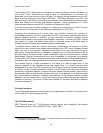
DIGITAL RADIO GUIDE APPENDIX A: EUREKA 147
98
The European CEPT channel plan encompasses four frequency bands, namely VHF Bands I, II
and III and L Band. Allotments were made to allow the implementation of two Eureka 147
ensembles in any given country or area in Europe. The majority of these allotments were in VHF
Band III and the lower part of the L Band (1452 MHz 1467 MHz). Allotments in the 230 240
MHz sub band of VHF Band III are subject to coordination with national defence users and the L
Band was divided into terrestrial and satellite segments. Further consideration of L Band
allotments was made at a second CEPT conference at Maastricht in 2002.
A second channel plan has been developed for Canada that covers only the L Band. This plan
also provides for 23 channels, but with different guard bands to the CEPT Plan.
Comparing the characteristics of the two plans, the Canadian channel plan provides an
interchannel guard band some 18% greater than the CEPT channel plan. Maximizing the spacing
between adjacent channels is desirable, as this contributes to improved adjacent channel
isolation which results in less stringent implementation constraints. In contrast, the CEPT channel
plan trades off a larger interchannel guard band for increased guards at the band edges to
facilitate sharing with other services operating near the band edges.
To facilitate receiver tuning and minimize scan times, manufacturers will assume, or at least
prioritise, the use of certain centre frequencies as defined by the CEPT and/or Canadian channel
plans. The use of ”non standard” frequencies could result in the need for manual tuning or,
alternatively, require the receiver to undertake a complete scan of the band(s) based on the 16
kHz grid spacing. The latter is likely to take considerably longer and could be seen as a distinct
disadvantage. Although manufacturers have been encouraged to incorporate the Canadian
channel plan in their designs, it remains unclear what level of support will be afforded to the plan
and whether there are cost implications for manufacturers in supporting both channel plans.
For Australia, there is a further complication if VHF Band III is used for digital radio. In this
scenario, adoption of the Canadian channel plan would result in a ”mixed” frequency table
arrangement (e.g., use of the CEPT channel plan at VHF Band III and the Canadian channel plan
at L Band). In view of these uncertainties, adoption of the Canadian channel plan would appear
justified only if significant benefits, in terms of improved adjacent channel isolation, were shown to
be associated with the wider channel spacing of this plan. In the absence of any published data,
the Communications Laboratory undertook measurements of the adjacent channel isolation
afforded by the two channel plans, using a limited range of transmitting and receiving equipment
available at that time. The results of these tests indicate no significant difference in adjacent
channel performance.
18
Planning Parameters
The planning parameters that could be used for the implementation of Eureka 147 services draw
on a number of ITU and European sources:
The ITU DSB Handbook
EBU ”Technical bases for T DAB services network planning and compatibility with existing
broadcasting services,” Document BPN 003 Rev. 1, May 1998;
18
Communications Laboratory Technical Note 99/01, ‘The impact of European and Canadian L-Band channel spacings
on adjacent channel operation”, 20 April 1999.


















